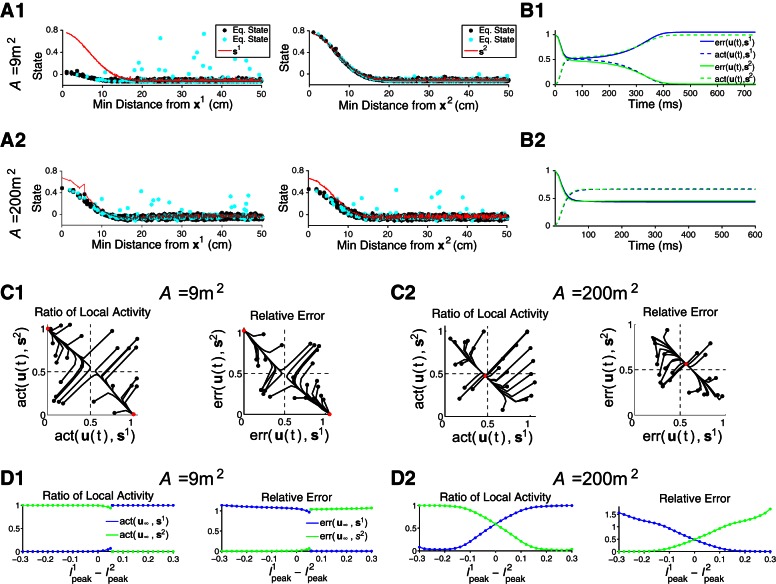Fig. 11.
Dynamics of the operational modes. Conflicting external input signaling for 2 locations (x1 and x2) reveals functional differences between a megamap representing 9 m2, which operates in the WTA mode, and a megamap representing 200 m2, which operates in the combinatorial mode (Fig. 10A). The external input is given by Eq. 14, where Ipeak1 = Ipeak2 = 0.15 for A–C. A: the small megamap ignores the signal for x1 and fully represents x2 (A1), whereas the large megamap represents both locations (A2). The equilibrium state (Eq. state; data points; also shown in Fig. 10E) is plotted as a function of the minimal distance between the given cell's place field centers and x1 (left) or x2 (right). Red curves show si, the equilibrium state given the single-peaked external input, I(xi; Ipeaki). Only cells with place fields near x2 are active for the small megamap, where the states of cells with place field centers within 50 cm of both x1 and x2 are highlighted in cyan. B: although 2 activity bumps emerge from the random initial state of each megamap, the co-active bumps are stable only in sufficiently large environments. We quantify the network's representation of each location in 2 ways: err[u(t), si], the relative 2-norm error between the state vector u(t) and si (solid); and act[u(t), si], the ratio of the corresponding activity (Eq. 7) summed over all cells with a place field center within 10 cm of xi (dashed). C: the small megamap shows hysteresis (C1), but the large megamap combines the representation of each location regardless of the initial state (C2). Black curves show the evolution of the activity ratio (left) and relative error (right) from their initial values (black dots) to their equilibrium values (red dots). D: the small megamap pattern separates, its equilibrium state (u∞) sharply transitioning from s2 to s1 as the external input gradually shifts from I(x2; 0.3) to I(x1; 0.3) (D1). The large megamap gradually transitions between the 2 embedded activity bumps, amplifying the difference in the input signals (D2). In both cases, u(0) = s2.

